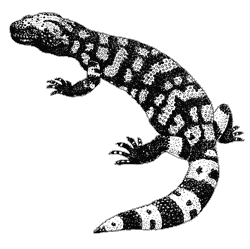Gila monster (Heloderma suspectum)
Order: Squamata
Family: Helodermatidae (venomous beaded lizards)
Spanish name: escorpión
Distinguishing Features
The Gila monster is a large, heavy- bodied lizard reaching a little over 1¼ feet in length. The head is large, with small, beady eyes; the tail is short and fat. The family name Helodermatidae means “warty skin,” referring to the beaded look of the dorsal scales, due to the presence of osteoderms (small bones) under the scales. The lizard is bright pink and black, usually in a reticulated pattern, but in a banded pattern in some populations.
Click to hear Gila Monster sounds
Range
The bulk of this lizard’s range is in western and southern Arizona, continuing to southern Sonora, Mexico, but it can also be found in extreme southeastern California, southern Nevada, extreme southwestern Utah, and southwestern New Mexico.
Habitat
The Gila monster is most commonly found in mountain foothills dominated by saguaros and palo verde trees. It also uses washes that extend down into valleys. It may use burrows dug by other animals, or construct burrows of its own.
Life History

Gila monsters prey on newborn rodents, rabbits, and hares, though ground nesting birds and lizards, as well as eggs from birds, lizards, snakes and tortoises are also eaten. Young Gila monsters may consume as much as 50 percent of their body weight in one feeding, while adults are capable of consuming 35 percent of their body weight in a single feeding. They are active mainly during the day from March through November, and may be seen basking at the entrances to their shelters in winter and early spring. Hibernation takes place from the end of November through February. Some sources estimate they spend up to 98 percent of their time in their subterranean shelters. Generally an animal occupies two burrows over the course of a year, one from autumn through early spring and another during the warmer spring and summer months. The latter burrow is usually in or near a bajada, while a higher elevation, foothill burrow is used when cooler temperatures arrive. Little is known about reproduction in the wild. An average of 5 eggs, but as many as 12, may be laid in late summer. In southern Arizona, Gila monsters breed in May and June, with eggs laid in late June through mid August. The eggs incubate and develop from fall to early spring; young appear the following April through June. There is no other known egg-laying lizard in North America where eggs over-winter and hatch the following year.
Comments
Gila monsters are one of only two venomous lizards known to occur in the world. The other, the beaded lizard (Heloderma horridum), is found in southern Sonora and further south in thornscrub and tropical deciduous forest.
Venom is produced in glands in the lower jaw and expressed along grooved teeth as the animal bites. Once the lizard bites, it generally holds on and chews more of the venom into its victim. Though the bite is rarely life-threatening to humans, it may cause pain, edema, bleeding, nausea and vomiting. A Gila monster’s venom is believed to be a defensive weapon. The animal probably does not need venom to subdue its defenseless prey and the intense pain caused by the venom readily causes a predator to change its mind. Before biting, the lizard will hiss, gape, and back away from its would-be attacker. If these efforts fail, it will bite with amazing speed. Gila monsters should not be handled!
Reptiles, especially venomous ones, are often poorly understood and greatly feared. With the Gila monster this combination has led to misinformation and the generation of many myths. Interesting but untrue are stories about how the Gila monster is venomous because it lacks an anus and “all that stuff went bad in there.” Or about how “once they bite down, they can’t let go until sundown,” or “if one bites you, don’t worry, it has to turn upside down to get the venom in you.” In 1952 the Gila monster became the first venomous animal in North America to be afforded legal protection; it is therefore illegal to collect, kill, or sell them in Arizona. Though it is an animal with a fairly large range, it has a spotty distribution primarily clumped around mountain ranges.
Dr. Ward’s Prescription
Dr. Ward, of Phoenix, an old practitioner in the valley, says: “I have never been called to attend a case of Gila monster bite, and I don’t want to be. I think a man who is fool enough to get bitten by a Gila monster ought to die. The creature is so sluggish and slow of movement that the victim of its bite is compelled to help largely in order to get bitten.”
September 23, 1899